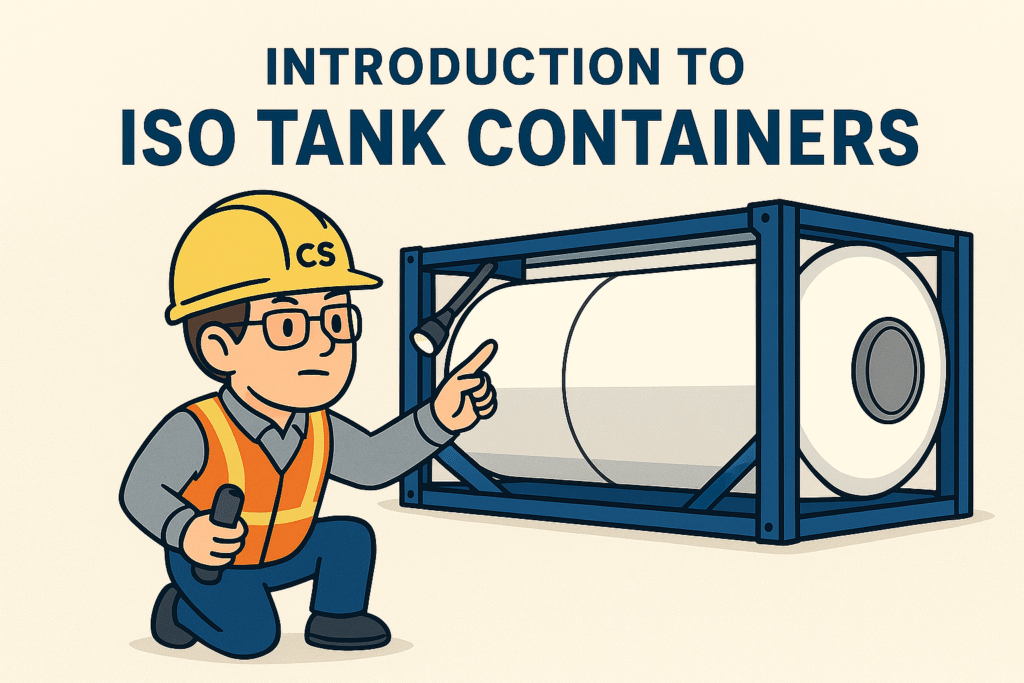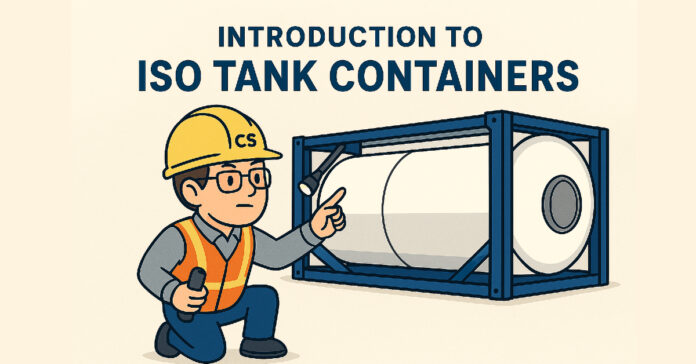Table of Contents
What is an ISO tank Container?
A ISO Tank Containers is a multimodal ISO-framed pressure vessel that is used to transport liquids, gases, and powders. Cylindrical shaped tank containers are not just used for shipping, they can be used for storing the hazardous and non-hazardous materials. Another feature for isotank is reusability and can be moved by container ships, railroads and trucks; Also, this withstands the most extreme weather conditions.
In the business world, a UN portable tank enclosed in an intermodal ISO frame is referred to as a “Tank Container,” “ISO tank,” ISO tank container”, “ISO tankers”, “ISOtainer” “Tanktainer”, or simply “Tank”. ISO tank Containers are typically measure 20 feet and manufactured in accordance with the physical dimensions specified by ISO.
ISO tank containers are specially designed, standardized shipping units used for transporting bulk liquids across the globe. Built according to the International Organization for Standardization (ISO) specifications, these containers provide a safe, efficient, and cost-effective solution for moving hazardous and non-hazardous liquids, including chemicals, food-grade products, fuels, and gases. Their popularity continues to grow as industries seek reliable methods to move liquid cargo without spillage or contamination.
Unlike drums or flexi-tanks, ISO tank containers are reusable, eco-friendly, and can handle multiple trips over many years. This makes them not only cost-efficient but also an environmentally sustainable choice for global logistics.

Key Features of ISO Tank Containers
Every ISO tank container is designed with high-grade stainless steel, enclosed in an insulated protective frame. The container body is cylindrical, with capacities typically ranging from 14,000 to 26,000 liters. Depending on the cargo type, these tanks may also include heating and refrigeration systems to maintain product integrity during long voyages.
Some standout features include:
- Durability: Built with corrosion-resistant stainless steel.
- Safety: Equipped with relief valves and protective insulation.
- Standardization: ISO compliance ensures they can be transported by ship, rail, or truck without modification.
- Flexibility: Capable of carrying a wide variety of liquid products.
Types of ISO Tank Containers
To meet different industry needs, ISO tank containers come in several types. Choosing the right type ensures cargo safety and compliance with international regulations.
1. Standard Tank Containers
These are the most common, used for transporting non-hazardous liquids such as water, wine, edible oils, and certain chemicals.
2. Food-Grade Tank Containers
Manufactured with food-safe materials and coatings, these tanks carry juices, milk, spirits, and other consumables without risk of contamination.
3. Gas ISO Tank Containers
Built with reinforced safety features to transport liquefied gases such as LPG, LNG, and ammonia under high pressure.
4. Chemical ISO Tank Containers
Specially designed to carry hazardous and corrosive chemicals. They often include protective linings, advanced insulation, and pressure regulation systems.
5. Refrigerated Tank Containers
For cargo that requires controlled temperatures, such as certain food products, pharmaceuticals, and specialty chemicals.
Advantages of Using ISO Tank Containers
ISO tank containers have become a trusted solution for industries worldwide due to their long list of benefits.
- Safety and Security: Designed to prevent leaks and contamination.
- Cost Efficiency: Their reusability reduces packaging and disposal costs compared to drums.
- Environmental Friendliness: Lower carbon footprint due to reduced waste.
- Global Standardization: Accepted by shipping lines, ports, and customs across the world.
- Versatility: Can transport thousands of different liquid products.
- Durability: Long service life, often exceeding 20 years with proper maintenance.
Applications of ISO Tank Containers
ISO tank containers serve a wide range of industries that require reliable transport of liquids and gases. Some notable sectors include:
- Chemical Industry: Transport of acids, solvents, resins, and hazardous liquids.
- Food and Beverage: Movement of juices, edible oils, wines, spirits, and milk.
- Energy and Gas: Shipping LPG, LNG, and other liquid gases.
- Pharmaceuticals: Safe handling of sensitive liquid medicines and intermediates.
- Agriculture: Fertilizer and liquid agricultural chemical distribution.
ISO Standards and Compliance
Every ISO tank container must comply with ISO 1496/3 regulations, which cover construction, testing, and maintenance. Additionally, depending on the cargo, they must meet safety standards from organizations such as:
- ADR (Europe)
- IMDG (International Maritime Dangerous Goods Code)
- US DOT (Department of Transportation)
This global compliance ensures smooth operations across borders and enhances trust between shippers and customers.
Maintenance and Safety Checks
While ISO tank containers are built for long service life, proper maintenance is essential for safety and compliance. Operators and owners typically follow strict routines:
- Regular Cleaning: To avoid cross-contamination between different cargoes.
- Inspection of Valves and Seals: Ensures no leakage during transit.
- Pressure Testing: Confirms the container can withstand required operating pressures.
- Coating and Insulation Checks: Especially important for corrosive and temperature-sensitive cargo.
ISO Tank Containers vs. Flexi-Tanks and Drums
Shippers often compare ISO tank containers with other packaging methods such as flexi-tanks and drums. Here’s how they differ:
- Capacity: One ISO tank container equals about 20,000 liters, replacing nearly 1,000 drums.
- Safety: ISO tanks are more secure, reducing the risk of leaks.
- Reusability: Unlike single-use flexi-tanks, ISO tanks can be used repeatedly for years.
- Cost: Although the upfront cost is higher, overall logistics costs are lower in the long term.
Future of ISO Tank Containers
As global trade continues to expand, ISO tank containers will play a critical role in supporting efficient and sustainable logistics. Trends shaping the future include:
- Digital Monitoring Systems: Smart sensors to track temperature, pressure, and cargo status in real time.
- Eco-Friendly Materials: Development of lighter, more sustainable tank materials.
- Expanded Use in Emerging Markets: Growth in Asia, Africa, and Latin America.
- Stricter Environmental Regulations: Encouraging industries to switch from single-use packaging to ISO tank containers.
Size & Type Codes of ISO Tank Containers
| Container Type | (Length x Height x Width) |
|---|---|
| 20T0 ISO Tank Container | (20′ x 8′ x 8′) |
| 20T1 ISO Tank Container | (20′ x 8′ x 8′) |
| 20T2 ISO Tank Container | (20′ x 8′ x 8′) |
| 20T3 ISO Tank for Dangerous Liquid | (20′ x 8′ x 8′) |
| 20T4 ISO Tank for Dangerous Liquid | (20′ x 8′ x 8′) |
| 20T5 ISO Tank for Dangerous Liquid | (20′ x 8′ x 8′) |
| 20T6 ISO Tank for Dangerous Liquid | (20′ x 8′ x 8′) |
| 20T7 ISO Tank for Gas | (20′ x 8′ x 8′) |
| 20T8 ISO Tank for Gas | (20′ x 8′ x 8′) |
| 20T9 ISO Tank for Gas | (20′ x 8′ x 8′) |
| 22T0 ISO Tank Container | (20′ x 8’6” x 8′) |
| 22T1 ISO Tank Container | (20′ x 8’6” x 8′) |
| 22T2 ISO Tank Container | (20′ x 8’6” x 8′) |
| 22T3 ISO Tank for Dangerous Liquid | (20′ x 8’6” x 8′) |
| 22T4 ISO Tank for Dangerous Liquid | (20′ x 8’6” x 8′) |
| 22T5 ISO Tank for Dangerous Liquid | (20′ x 8’6” x 8′) |
| 22T6 ISO Tank for Dangerous Liquid | (20′ x 8’6” x 8′) |
| 22T7 ISO Tank for Gas | (20′ x 8’6” x 8′) |
| 22T8 ISO Tank for Gas | (20′ x 8’6” x 8′) |
| 26T0 High Cube ISO Tank | (20′ x 9’6” x 8′) |
| 28T8 ISO Tank for Gas | (20′ x 4’3” x 8′) |
| Container Type | (Length x Height x Width) |
|---|---|
| 42T2 ISO Tank Container | (40′ x 8’6” x 8′) |
| 42T5 ISO Tank for Dangerous Liquid | (40′ x 8’6” x 8′) |
| 42T6 ISO Tank for Dangerous Liquid | (40′ x 8’6” x 8′) |
| 42T8 ISO Tank for Gas | (40′ x 8’6” x 8′) |
| 48T8 ISO Tank for Gas | (40′ x 4’3” x 8′) |


